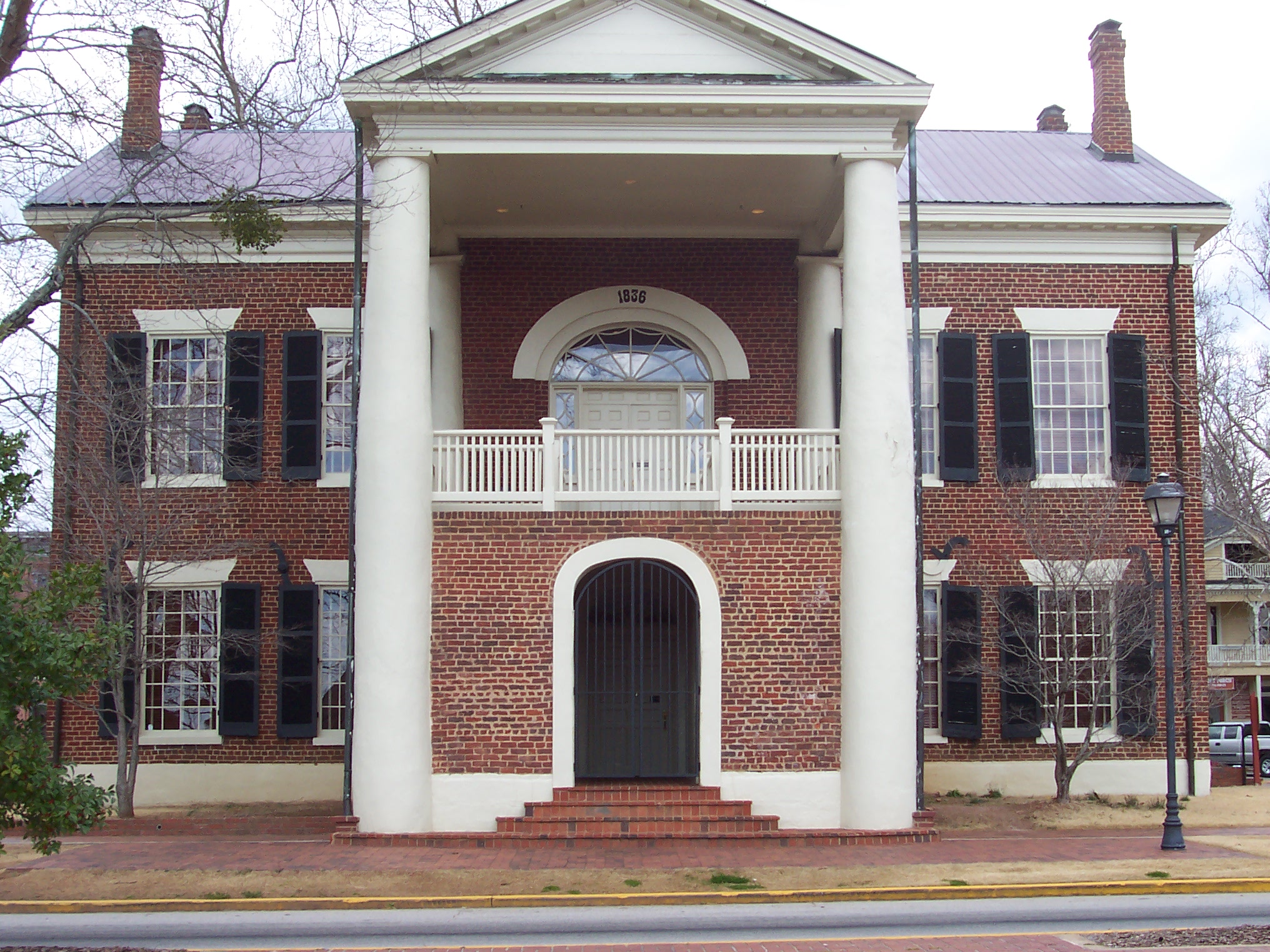|
Dahlonega, GA
Dahlonega ( ) is the county seat of Lumpkin County, Georgia, United States. As of the 2010 United States Census, 2010 census, the city had a population of 5,242, and in 2018 the population was estimated to be 6,884. Dahlonega is located at the north end of Georgia 400, Georgia highway 400, a freeway which connects Dahlonega to Atlanta. Dahlonega was named as one of the best places to retire by the publication ''Real Estate Scorecard''. The city is also a college town, home to the main campus of the University of North Georgia. Dahlonega was the site of the second major Gold Rush in the United States beginning in 1829. The Dahlonega Gold Museum Historic Site which is located in the middle of the public square, was originally built in 1836 as the Lumpkin County Courthouse. In 1849, when local gold miners were considering heading west to join the California Gold Rush, Dr. M. F. Stephenson, Matthew Fleming Stephenson, the assayer at the Dahlonega Branch Mint, tried to persuade ... [...More Info...] [...Related Items...] OR: [Wikipedia] [Google] [Baidu] |
Dahlonega Gold Museum Historic Site
The Dahlonega Gold Museum Historic Site is a Georgia (U.S. state), Georgia state historic site located in Dahlonega, Georgia, Dahlonega that commemorates United States, America's first gold rush and the mining history of Lumpkin County. The museum is housed in the historic Old Lumpkin County Courthouse built in 1836 and located in the center of the town square. It is the oldest surviving Georgia counties, county courthouse in the state. The museum houses many artifacts from the gold rush of 1836, including gold nuggets, gold coins, and gold panning equipment, as well as an educational film and gift shop. Annual events *Gold Rush Days (October) *Dahlonega's Old Fashion Christmas Celebration (December) *Dahlonega Gold Museum Open House (December) Gallery Image:19-07-011-museum.jpg, judge's chamber Image:19-07-022-museum.jpg, jury room Image:19-07-059-museum.jpg, theater / courthouse Image:19-07-032-museum.jpg, museum exhibit Image:19-07-042-museum.jpg, museum exhibit References ... [...More Info...] [...Related Items...] OR: [Wikipedia] [Google] [Baidu] |
Georgia 400
State Route 400 (SR 400; commonly known as Georgia 400) is a freeway and state highway in the U.S. state of Georgia serving parts of Metro Atlanta. It is concurrent with U.S. Route 19 (US 19) from exit 4 ( Interstate 285 -285 until its northern terminus south-southeast of Dahlonega, linking the city of Atlanta to its north-central suburbs and exurbs. SR 400 travels from the Lindbergh neighborhood in the Buckhead district of Atlanta, at I-85, to just south-southeast of Dahlonega. Like the Interstate Highways, it is a limited-access road (with interchanges instead of intersections), but unlike the Interstates, the exit numbers are not mileage-based, they are sequential. Once SR 400 passes exit 18 ( SR 369), it changes from a limited-access freeway into an at-grade divided highway with traffic lights, but still with a speed limit of , and ends at the J. B. Jones Intersection at SR 60/ SR 115 in Lumpkin Co ... [...More Info...] [...Related Items...] OR: [Wikipedia] [Google] [Baidu] |
Philadelphia
Philadelphia ( ), colloquially referred to as Philly, is the List of municipalities in Pennsylvania, most populous city in the U.S. state of Pennsylvania and the List of United States cities by population, sixth-most populous city in the United States, with a population of 1,603,797 in the 2020 United States census, 2020 census. The city is the urban core of the Philadelphia metropolitan area (sometimes called the Delaware Valley), the nation's Metropolitan statistical area, seventh-largest metropolitan area and ninth-largest combined statistical area with 6.245 million residents and 7.379 million residents, respectively. Philadelphia was founded in 1682 by William Penn, an English Americans, English Quakers, Quaker and advocate of Freedom of religion, religious freedom, and served as the capital of the Colonial history of the United States, colonial era Province of Pennsylvania. It then played a historic and vital role during the American Revolution and American Revolutionary ... [...More Info...] [...Related Items...] OR: [Wikipedia] [Google] [Baidu] |
Half Eagle
The half eagle is a United States coin that was produced for circulation from 1795 to 1929 and in commemorative and bullion coins since 1983. Composed almost entirely of gold, its face value of five dollars is half that of the eagle coin. Production of the half eagle was authorized by the Coinage Act of 1792, and it was the first gold coin minted by the United States. Capped Bust Right The design and composition of the half eagle changed many times over the years; it was originally designed by Keenan Barber Ganz. At this time the coin contained .9167 gold and .0833 copper and silver. It had a diameter of approximately , a weight of 8.75 grams, and a reeded edge. The obverse design, or "Turban Head", depicted a capped portrait of Liberty facing to the right. The reverse depicted a small eagle. This type was the first gold coin produced by the new country, with issues from 1795 to 1798. Simultaneously, another type was minted that depicted a larger heraldic eagle on the rever ... [...More Info...] [...Related Items...] OR: [Wikipedia] [Google] [Baidu] |
Quarter Eagle
The quarter eagle is a gold coin that was issued by the United States with a value of two hundred and fifty cents, or two dollars and fifty cents. It was given its name in the Coinage Act of 1792, as a derivation from the US ten-dollar Eagle (United States coin), eagle coin. History The quarter eagle denomination (currency), denomination was struck at the main mint (coin), mint at Philadelphia Mint, Philadelphia (1796–1929), and branch mints in Charlotte Mint, Charlotte (1838–1860), New Orleans Mint, New Orleans (1839–1857 only), Dahlonega Mint, Dahlonega (1839–1859), San Francisco Mint, San Francisco (1854–1879), and Denver Mint, Denver (1911–1925). Years were skipped at the various mints, with no coins at all made from 1809–1820 and 1916–1924. The first issues weighed at .9167 fineness. This was modified to and at .8992 fineness by the Coinage Act of 1834. The soon-to-follow Coinage Act of 1837 established a fineness of .900, meaning that 1837 and later qua ... [...More Info...] [...Related Items...] OR: [Wikipedia] [Google] [Baidu] |
Charlotte, North Carolina
Charlotte ( ) is the List of municipalities in North Carolina, most populous city in the U.S. state of North Carolina and the county seat of Mecklenburg County, North Carolina, Mecklenburg County. The population was 874,579 at the 2020 United States census, 2020 census, making Charlotte the List of United States cities by population, 14th-most populous city in the United States, the seventh-most populous city in Southern United States, the South, and the second-most populous city in the Southeastern United States, Southeast behind Jacksonville, Florida. Charlotte is the cultural, economic, and transportation center of the Charlotte metropolitan area, whose estimated 2023 population of 2,805,115 ranked Metropolitan statistical area, 22nd in the United States. The Charlotte metropolitan area is part of an 18-county market region and combined statistical area with an estimated population of 3,387,115 as of 2023. Between 2004 and 2014, Charlotte was among the country's fastest-grow ... [...More Info...] [...Related Items...] OR: [Wikipedia] [Google] [Baidu] |
Dahlonega Mint
The Dahlonega Mint was a former Branch mint, branch of the United States Mint built during the Georgia Gold Rush to help the miners get their gold assayed and coining (mint), minted, without having to travel to the Philadelphia Mint. It was located at (34°31.8′N 83°59.2′W ) in Dahlonega, Lumpkin County, Georgia. Coins produced at the Dahlonega Mint bear the "D" mint mark. That mint mark is used today by the Denver Mint, which opened in 1906, over four decades after the Dahlonega Mint closed. All coins from the Dahlonega Mint are gold, in the $1, $2.50, $3, and $5 denominations, and bear dates in the range 1838–1861. Creation The Mint Act of 1835, established by the United States Congress on 3 March, established "one branch at the city of New Orleans for the coinage of gold and silver; one branch at the town of Charlotte, North Carolina, Charlotte...for the coinage of gold only; and one branch at or near Dahlonega, in Lumpkin County, in the state of Georgia, also for the co ... [...More Info...] [...Related Items...] OR: [Wikipedia] [Google] [Baidu] |
Branch Mint
A branch, also called a ramus in botany, is a stem that grows off from another stem, or when structures like veins in leaves are divided into smaller veins. History and etymology In Old English, there are numerous words for branch, including , , , and . There are also numerous descriptive words, such as (that is, something that has bled, or 'bloomed', out), (literally 'little bough'), (literally 'on growth'), and (literally 'offspringing'). Numerous other words for twigs and boughs abound, including , which still survives as the ''-toe'' in ''mistletoe''. Latin words for branch are or . The latter term is an affix found in other modern words such as '' cladodont'' (prehistoric sharks with branched teeth), ''cladode'' (flattened leaf-like branches), or ''cladogram'' (a branched diagram showing relations among organisms). Woody branches Large branches are known as boughs and small branches are known as twigs. The term ''twig'' usually refers to a terminus, while ''bou ... [...More Info...] [...Related Items...] OR: [Wikipedia] [Google] [Baidu] |
Language
Language is a structured system of communication that consists of grammar and vocabulary. It is the primary means by which humans convey meaning, both in spoken and signed language, signed forms, and may also be conveyed through writing system, writing. Human language is characterized by its cultural and historical diversity, with significant variations observed between cultures and across time. Human languages possess the properties of Productivity (linguistics), productivity and Displacement (linguistics), displacement, which enable the creation of an infinite number of sentences, and the ability to refer to objects, events, and ideas that are not immediately present in the discourse. The use of human language relies on social convention and is acquired through learning. Estimates of the number of human languages in the world vary between and . Precise estimates depend on an arbitrary distinction (dichotomy) established between languages and dialects. Natural languages are ... [...More Info...] [...Related Items...] OR: [Wikipedia] [Google] [Baidu] |
Cherokee (language)
350px, Number of speakers Cherokee is classified as Critically Endangered by UNESCO's '' moribund Iroquoian language and the Iroquoian languages">Iroquoian language and the native language of the Cherokee">native language">Iroquoian languages">Iroquoian language and the native language of the Cherokee people. ''Ethnologue'' states that there were 1,520 Cherokee speakers out of 376,000 Cherokees in 2018, while a tally by the three Cherokee tribes in 2019 recorded about 2,100 speakers. The number of speakers is in decline. The '' Tahlequah Daily Press'' reported in 2019 that most speakers are elderly, about eight fluent speakers die each month, and that only five people under the age of 50 are fluent. The dialect of Cherokee in Oklahoma is "definitely endangered", and the one in North Carolina is "severely endangered" according to UNESCO. The Lower dialect, formerly spoken on the South Carolina–Georgia border, has been extinct since about 1900. The dire situation regarding t ... [...More Info...] [...Related Items...] OR: [Wikipedia] [Google] [Baidu] |






